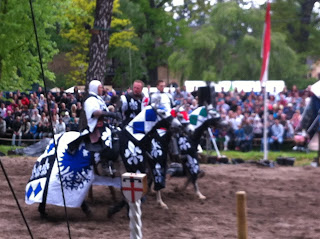 |
| Neuschwanstein Castle, taken from the Marienbrücke |
I have been loath to write about
this particular castle, but I think the time has come. There are an estimated 20,000
castles and castle ruins within Germany – and so many interesting ones that people
outside of Germany don’t know about. But, I would be remiss in having a blog
about German castles if I don’t mention the most iconic castle in Germany,
Neuschwanstein.
Neuschwanstein
was the dream castle built by the Bavarian king, Ludwig II. Ludwig was born in
August 1845 in Munich to King Maximilian II of Bavaria. Maximilian had acquired
the castle Hohenschwangau in the Bavarian Alps near Fussen. This site was the
seat of the legendary Swan Knights from the middle ages. He rebuilt
Hohenschwangau castle in 1832 in Gothic style, and had scenes of the famous
legends and stories of the middle ages painted in murals throughout the castle.
Ludwig grew up in the family castle at Hohenschwangau, and dreamed of the glory
of the middle ages that surrounded him.
In 1861,
Ludwig saw his first Richard Wagner opera in Munich, Lohengrin, which recounted one of the many stories of the Swan
Knights. He became enamored with Wagner’s music and operas.
 |
| Neuschwanstein Castle |
Upon the death of King Maximilian
in 1864, Ludwig II became King of Bavaria at the age of 18. Although he was
well-educated and well-read, he was not well-versed in the intricacies of
politics. A mere two years later, he was subjugated to the Prussian Empire and
was no longer a sovereign ruler. He became a constitutional monarch, answerable
to two houses of parliament in Bavaria. He withdrew from court, and many
believe he began living in his own little world. In
1864, the same year he became King of Bavaria, he also became a patron of
Richard Wagner.
On the 22nd of January,
1867, Ludwig was engaged to marry his cousin, Princess Sophie Charlotte of
Bavaria. Unfortunately, he was really in love with her sister, Empress
Elizabeth of Austria (Sissy). The marriage coach was built and commemorative
medals were minted. However, Ludwig dissolved his engagement on the 10th
of October of the same year. From that point forward, he never again thought of
marriage.
 |
| Neuschwanstein Castle |
Ludwig visited Wartburg castle in
Thuringia in 1867, and Wartburg became the inspiration for Neuschwanstein
(translated as “New Swan Stone”). He built Neuschwanstein near his childhood
home at Hohenschwangau in the place of two Swan Knight castle ruins –
Vorschwangau and Hinterschwangau. Neuschwanstein was built in neo-Romanesque
style, harkening back to a medieval castle style. Construction began in 1869,
but the castle was never completed. He envisioned that Neuschwanstein would be
the new center for the Order of the Swan Knights (according to some legends,
the keepers of the Holy Grail), and he envisioned himself to be the Grand
Master. The pictures and art in his castle were inspired by the medieval
legends in Wagner’s operas. Richard Wagner died in Venice in 1886, never having
seen Neuschwanstein. Ludwig moved into the incomplete Neuschwanstein the same
year and holed himself up there. He lived there a total of 172 days.
Ludwig was
seen as eccentric in his day, and was renowned for his eccentricities much like
Michael Jackson is today. He was an insomniac, and spent his nights wandering
the castle, while sleeping his days away. He loved solitude, dreaming, art and
history. He had his castle outfitted
with the latest inventions of the industrial revolution, such as electricity.
Although heavily in debt, he continued to build his castle. Many felt he was
using too much of Bavaria’s money on what they considered to be his folly.
 |
| View of Hohenschwangau, taken from Neuschwanstein |
While he
was holed up in Neuschwanstein, scheming Bavarian ministers succeeded in taking
over his power. They arrested him at Neuschwanstein for lunacy and put him in
the Berg castle on the bank of Lake Sternberg. On the very next day after his
arrest, on 13 June 1886, the King’s body was found in the lake. The body of the
King’s doctor, Dr von Gudden (who had declared him insane and unfit to rule the
day previous, without any examination) was found nearby. The King was an
excellent swimmer, and his body was found in a very shallow part of the lake.
Many conspiracy theories surround this incident. The official verdict was that
the King killed Dr von Gudden and then committed suicide.
Before the construction of
Disneyland, Walt Disney and his wife Lillian took a European tour. A Disneyland
representative confirms that the time he spent at Neuschwanstein Castle was the
inspiration behind Disney’s Sleeping Beauty Castle. Neuschwanstein features
prominently in the 1968 movie, Chitty
Chitty Bang Bang, starring Dick van Dyke and the 2014 movie, Monument’s Men, by George Clooney, among many others.
 |
| Disneyland's Sleeping Beauty Castle |





























